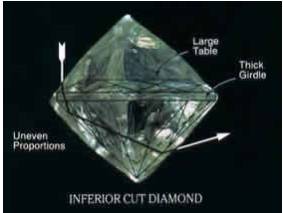When it comes to purchasing jewellery with diamonds, replacing missing diamonds in your jewellery, or purchasing a diamond for engagement purposes, it important to understand what you are purchasing.
At The Goldsmith, we know that one diamond is not like another, and we can help you to make the right decision with regards to your purchase. We can help you find that special diamond that you are looking for.
Here below, is a detailed explanation of 4C’s of Diamonds.
The 4 C's, when referring to diamond value, are color, clarity, carat weight and cut. All four factors are equally important in determining the final cost of a diamond. The criteria for diamond grading, most respected internationally, was developed by the Gemological Institute of America (the G.I.A.). The terminology and systems described on this page, are those of the G.I.A.
Following, is an explanation of these terms.
Color
The color of a diamond refers to the relative amount of yellow, brown or gray body color that a stone possesses. The G.I.A. scale starts at "D" and goes through "Z", with "D" being void of any body color, and "Z" having a light yellow, brown or gray color.

With actual stones, the color difference would appear like this:

Clarity
Practically all diamonds contain naturally occurring internal characteristics called inclusions. The size, nature, location and amount of inclusions determine a stone's clarity grade and affect its cost. Clarity is determined using 10X magnification. By definition, if something is not visible at 10X, it does not effect the clarity.
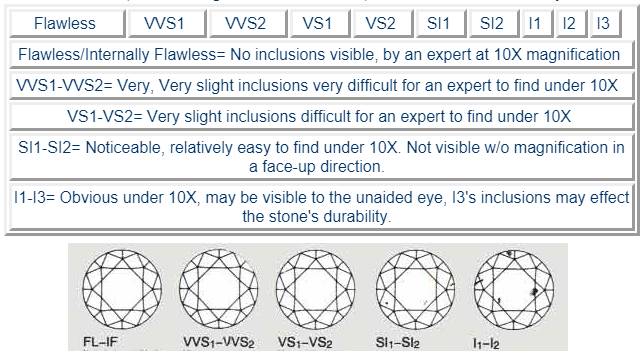
Carat Weight
Carat is a unit of weight, not size. There are 5 carats in a gram. The weight of a diamond is measured in carats. A carat is divided into 100 parts, called points.
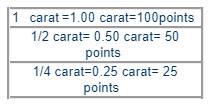
Cut
At the turn of the last century, it was mathematically determined, what the optimal proportions for a diamond should be to assure maximum brilliance and dispersion.
Those proportions are as follows:
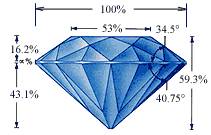
The quality of a diamond's cut makes all the difference in how the stone appears. A poorly cut "D", Flawless stone, can look dead and lifeless, whereas an ideally proportioned diamond of much lower color and clarity will appear radiant and dazzling. So, why aren't all diamonds ideally proportioned? The answer is quite simple. Diamonds are sold by weight. Stones cut to ideal proportions waste more of the diamond crystal, therefore weigh less than stones that are cut to maximize weight.
Here are examples:
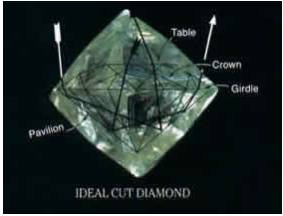
The diamond below will weigh more because of the shallow crown, and exaggerated table size. Not to mention, that another diamond of shallow proportions could be cut from the remaining crystal.
